MARIANI’S
November
5, 2006
NEWSLETTER

The Brown Derby restaurant, Los Angeles, circa 1926
UPDATE: To
go to my web site, in which I will update food
&
travel information and help link readers to other first-rate travel
& food sites, click on: home page
ACCESS TO
ARCHIVE: Readers may now access
an
Archive of all past newsletters--each annotated--dating back to July,
2003, by simply clicking on www.johnmariani.com/archive
.
NEW
FEATURE! You may now subscribe anyone you wish
to this newsletter by
clicking here.
In
This Issue
NEW YORK CORNER: La Cantina Toscana by John Mariani
QUICK BYTES
THE FOIE GRAS DEBATE
by John Mariani
 In
California, Gov. Arnold Schwarzenegger
(below), who knows a bit about
pumping up with protein, signed a bill last spring outlawing
the production of foie gras in California, to go into effect several
years hence and affecting just one single producer in the state, Gonzalez's Sonoma
Foie Gras, which must go out of business unless they can find a way to
make foie gras without "too much stress on the animal."
In
California, Gov. Arnold Schwarzenegger
(below), who knows a bit about
pumping up with protein, signed a bill last spring outlawing
the production of foie gras in California, to go into effect several
years hence and affecting just one single producer in the state, Gonzalez's Sonoma
Foie Gras, which must go out of business unless they can find a way to
make foie gras without "too much stress on the animal."The irate, ill-informed constituency that is now opposing, state by state, city by city, the production, sale, purchase, of eating of foie gras has reached the point where producers and restaurateurs now fear for their own and their families' lives after physical threats against them from some zealots who believe the destruction of a human life is a rational antidote to what they feel is an inhumane practice.
In Chicago the ban on foie gras has been an embarrassment to the City Council that passed it, even to the point of having the Mayor consider a legislative repeal. Now comes a passel of ignorant New Jersey legislators who, without knowing the facts of animal husbandry, assume the practice of fattening ducks for their liver to be wholly, irredeemably inhumane; their bill would effectively stop their state's D'Artagnan company (which buys its foie gras from the only other producer in the USA, Hudson Valley Foie Gras.
The answer to these vocal, often belligerent critics is simply to not eat foie gras if it offends them. But those who believe that human beings should stop the raising and slaughter of all animals--cattle, chickens, fish--are on a crusade to do just that, and foie gras, considered the decadent end product of an inhumane practice, is just the easiest target. PETA (People for the Ethical Treatment of Animals) proclaims on its website that the "goal is to enlarge the animal's liver up to ten times its normal size" and that, "many birds become too sick to walk." There is no evidence that the sponsors of any of the current bills have ever visited an American foie gras farm. If they did, they might find evidence that the ducks raised for foie gras production are treated at least as well cared for and probably better than most animals in the food chain. An unhealthy animal is, obviously, not an animal that can be used for food.
Allow me, then, to reprint a message that Ariane Daguin (below), CEO and owner of D'Artagnan, Inc., sent to her consumers, which I think gives a far more balanced view of what actually goes on in the production of American foie gras.
--John Mariani
Raising ducks for foie gras is humane. That's the only fair conclusion if you base your assessment on unbiased scientists and veterinarians rather than anti-meat activists. Foie gras farming has been extensively researched by scientists and is in the mainstream of animal agriculture. The artisanal duck farms and processing facilities comply with all state and federal regulations, including the rigorous food safety requirements of the U.S. Department of Agriculture. To produce foie gras, the birds are hand-fed by producers two to three times a day over a two- to four-week period. Each feeding takes only approximately 20 seconds. Our flocks are in excellent health and our mortality rates are among the lowest in poultry farming.
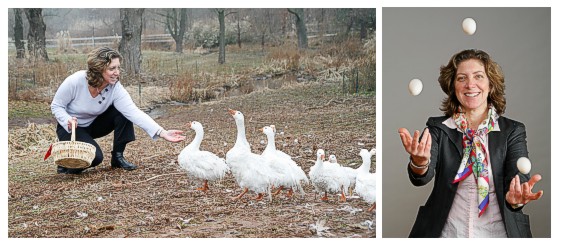
Proof points:
· The American Veterinary Medical Association's House of Delegates has twice rejected resolutions opposing the practice of force feeding ducks and geese to produce foie gras, determining that the feeding technique had minimal adverse effects on the birds involved. In 2006, the AVMA sent a blue-ribbon panel to personally observe foie gras farming practices, and the panel recommended that the AVMA oppose the anti-foie gras resolution.
· A 2004 study in the World's Poultry Science Journal concluded that ducks and geese physiologically engage in a natural fattening phenomenon. Further, the study found that the feeding procedure produced neither physiological indicators nor behavioral responses indicating stress. It concluded foie gras was a "non-harmful" product to ducks. Stress levels in these studies were determined scientifically by taking of blood samples to measure the levels of corticosterone, a hormone released when birds are under stress, and by behavioral observation.
· A 2001 published scientific study measured the reactions of ducks and geese to the farmers who feed them on foie gras farms. There were no signs of avoidance in geese, and ducks displayed less avoidance to feeders than to unknown persons not performing any feeding. There was absolutely no aversion to the feeders over the course of the feeding process. Despite a normal avoidance in animals of stimuli associated with pain, ducks on foie gras farms "show little or no avoidance of force feeding procedure."
· The AFA is happy to provide copies of scientific studies to those interested in learning the objective truth of the matter.
· Dr. Y.M. Saif, a delegate from the American Association of Avian Pathologists, found that mortality is low and that the feeding personnel are highly trained.
· Claims of "exploding livers" are simply outlandish. Neither the scientific reviews nor countless fact-finding missions to foie gras farms support any such claims.
Foie gras is a natural product. Ducks and geese naturally store fat in the liver for use as energy during long migratory flights. The fatty livers produced by foie gras are healthy and the effects are reversible. Claims that foie gras is "diseased" are preposterous and wholly unsupported by science. The artisanal duck farms and processing facilities comply with all state and federal regulations, including the rigorous food safety requirements of the U.S. Department of Agriculture. --Ariane Daguin, D'Artagnan, Inc.
AND ON ANOTHER MATTER...
![]lll](fgs.axd.jpg) A very telling article appeared in
the NY Times on October 29
about the data showing not only that smoking bans in restaurants and
other public places have had a remarkable impact on the health of
people formerly affected by it but that business is actually up at
restaurants and cafés, and that there is overwhelming support
for such bans even in righteously anti-regulatory countries like Italy,
where it has been an enormous success. Here are a few stats from the
article:
A very telling article appeared in
the NY Times on October 29
about the data showing not only that smoking bans in restaurants and
other public places have had a remarkable impact on the health of
people formerly affected by it but that business is actually up at
restaurants and cafés, and that there is overwhelming support
for such bans even in righteously anti-regulatory countries like Italy,
where it has been an enormous success. Here are a few stats from the
article:-Cigarette sales in Italy have dropped 8 percent, and among young people 15-24, the drop was 23 percent.
-One poll in Italy indicated that since the ban, 9.6 percent of people said they go out more often, and 7.4 percent less so.
-Now, two years after the ban went into effect, 90 percent of Italians say they are in favor of it.
-A study in Turin found that since the ban, heart attack victims decreased in emergency rooms.
-Despite warnings that authorities and restaurateurs would simply ignore the ban, there is now 100 percent compliance.
Similar findings have been published in other sources about the results of bans in Scandinavia and Ireland. Next up, France, in 2008.
NEW YORK CORNER
by John Mariani
La Cantina Toscana
212-754-5454
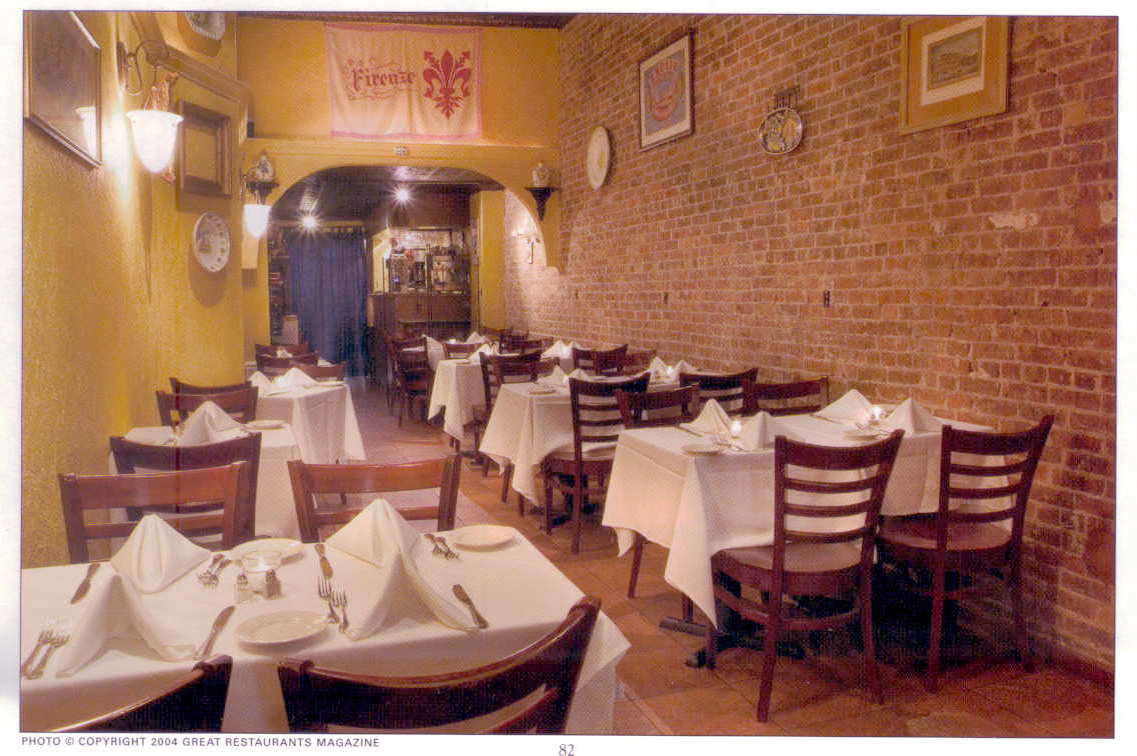 Chef/restaurateur Pierluigi Sacchetti and
his partner and wine
director Massimiliano Caldini are themselves proud Florentines, and
they've made their little slip of a trattoria very much in the style of
those in their hometown, with wooden tables lighted with candles and
set with Tuscan ceramic plates, terracotta floors, brick walls, and
Chef/restaurateur Pierluigi Sacchetti and
his partner and wine
director Massimiliano Caldini are themselves proud Florentines, and
they've made their little slip of a trattoria very much in the style of
those in their hometown, with wooden tables lighted with candles and
set with Tuscan ceramic plates, terracotta floors, brick walls, and La Cantina Toscana features about 200 Italian wines, including several older vintages bought at auction. The list has a “Wine Spectator Award of Excellence.”
You'll find the menu full of very hearty cooking, particularly in its game dishes, which are featured seasonally. It's a big menu for a small kitchen, but, aside from some very salty dishes, I found most of what I ate absolutely and uniquely delicious, beginning with antipasti like artichoke flan with pecorino cheese, and a very unusual item, cieche alla pisana (described as Mr. Sacchetti's "grandpa's favorites"), and flash-sautéed baby eels with garlic and oil, something you rarely see outside of Spanish restaurants that charge a fortune for them. Here the dish is $9.95.
Going for the gut, Sacchetti also serves the Tuscan equivalent of chitterlings, with an assertive pepper sauce, and I really loved his boiled tongue with a parsley and olive oil sauce. Just try to find any of these dishes around town at pseudo-Tuscan restaurants like the hyped-up Da Silvano (where Mr. Caldini once worked).
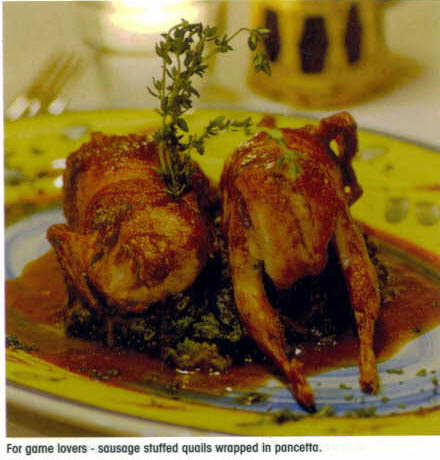 Pastas are every bit as impressive, including
housemade pappardelle with a
pheasant ragù, and an
amazingly good lasagne (O.K.,
this is more of a Bolognese
dish, but it's a magnificent example). Other pastas as yet untried
include ravioli with potatoes and pancetta in a sausage ragù, and lemon tagliolini with shrimp and
asparagus.
Pastas are every bit as impressive, including
housemade pappardelle with a
pheasant ragù, and an
amazingly good lasagne (O.K.,
this is more of a Bolognese
dish, but it's a magnificent example). Other pastas as yet untried
include ravioli with potatoes and pancetta in a sausage ragù, and lemon tagliolini with shrimp and
asparagus.These are all quite filling but push on to the secondi like slowly poached veal cheeks in a basil sauce with creamy polenta, or braised rabbit with olives, white wine, and thyme. There is, of course, an authentic bistecca all fiorentina here, perfumed with rosemary and set on a bed of arugula. Wild boar is marinated in red wine then stewed, served with Swiss chard and polenta, and two nice fat quails are stuffed with sausage and potatoes, then wrapped in pancetta and cooked to a golden, crisp turn, served with tender broccoli di rape.
Desserts are the usual Italian dolci but they are just fine.
Cantina Toscana is really a remarkable restaurant in its dedication to what its owners believe in. When you can find a restaurant where barely a single dish is familiar in the way 95 percent of the Italian menus in NYC are, then you have something that is not only special but to be respected.
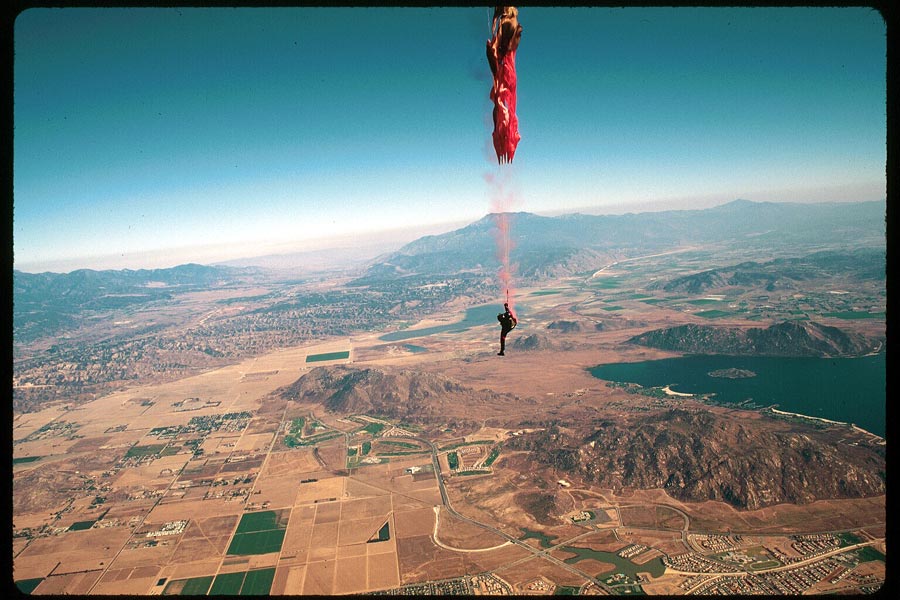 DIDN'T 007 DO THAT IN ONE OF
THE BOND MOVIES?
DIDN'T 007 DO THAT IN ONE OF
THE BOND MOVIES?TRY HARDER

"The desserts are a trip in themselves, thanks to the elaborate domes of caramelized spun sugar that decorate many of them. This shiny tracery so struck me when I first saw it that I immediately placed it on top of my head, as if Tim Gunn of Project Runway had charged me with making a wild beanie. Yes, it stuck to my hair; no, I didn't eat it. It was fun for a moment, though. I swear I couldn't help myself."--Alison Cook, "Chez Georges," Houston Chronicle (October 18, 2006).
QUICK BYTES
TO ALL PUBLICISTS: Owing to the amount of material sent to this newsletter regarding Christmas, and New Year's dinners--many of which are only announcements as to price fixed dinners--it is impossible for me to include any but the more unusual of events for those holidays in Quick Bytes. --John Mariani
* On Nov. 18 the Roof Terrace Restaurant at the
* Between Dec. 8 and Jan. 15, the Hotel d’Angleterre in Geneva, Switzerland, is offering a 2- night package incl. a bottle of "Vin des Glaciers" and welcome gift of deluxe tree ornament and a basket of "Biscôme"; daily buffet breakfast; cheese fondue in a typical chalet of the Jura; 4-course dinner at Windows, by chef Philippe Audonnet; cooking demo with Pastry Chef; access to the fitness and sauna; if staying on Christmas Day, a stocking stuffed with season goodies.
MARIANI'S VIRTUAL GOURMET NEWSLETTER is published weekly. Editor/Publisher:
John Mariani. Contributing Writers: Robert Mariani, Naomi
Kooker, Kirsten Skogerson, Edward Brivio, Mort
Hochstein, Suzanne Wright. Contributing
Photographers: Galina Stepanoff-Dargery, Bobby Pirillo. Technical
Advisor: Gerry McLoughlin.
Any of John Mariani's books below
may be ordered from amazon.com by clicking on the cover image.
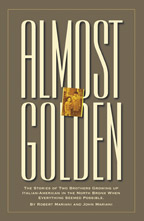 My
newest book, written with my brother Robert Mariani, is a memoir of our
years growing up in the My
newest book, written with my brother Robert Mariani, is a memoir of our
years growing up in the For those of you who don't think of the Robert and I think you'll enjoy this very personal look at our --John Mariani |
 |
 |
 |
 |
 |
 |
copyright John Mariani 2006